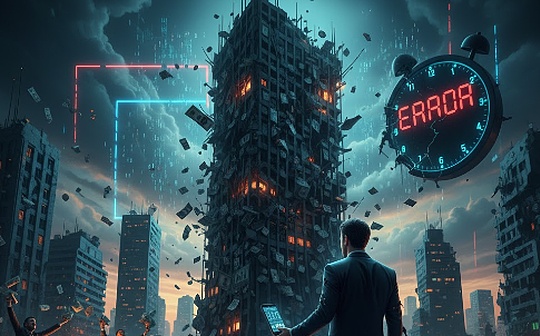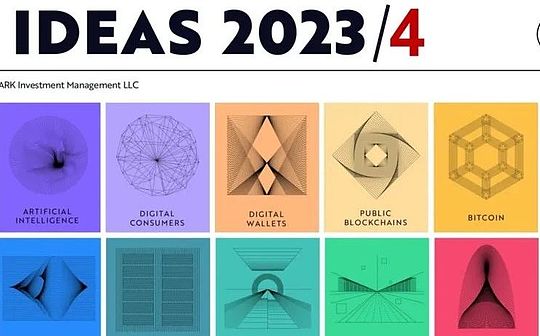
Written by: Will Awang
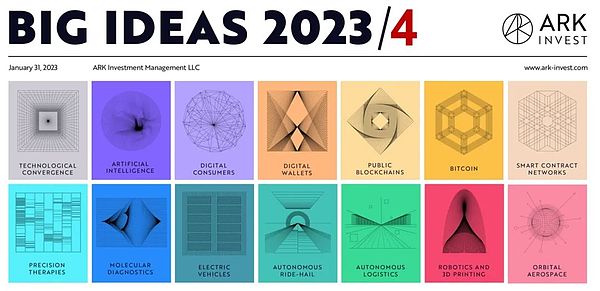
In early 2024, “Miss Wood” Wall Street investment manager “Miss Wood” led her ARK team to release the “Big Ideas 2024” report.The report aims to cover the global “disruptive innovation” field, with extremely high gold content and is an important reference material for global technology entrepreneurs and investors.
This article extracts content about cryptocurrencies and blockchain from two research reports on 2023/4 to sort it out, presenting a way to view Crypto from the perspective of Wall Street Fund.
In this, we can see the changes that public blockchain can bring to currency, finance, and the Internet, the solutions provided by smart contracts/DeFi for the real world, and the ability of digital wallets to combine crypto/blockchain payment, and bringThe growth rate of value.
1. The integration of five major technologies leads the next generation of revolution
ARK research report believes that the integration of disruptive innovative technologies will define the development of the next decade, and the current technological integration may trigger more profound macroeconomic changes than the first and second industrial revolutions.
AI, public blockchain, multi-microscience sequencing, energy storage and robotics, these five major technology platforms are integrating with each other and will change global economic activity, with economic growth likely to accelerate from an average of 3% over the past 125 years to the future.7% of 7 years.

The figure below shows the impact of previous technological revolutions such as steam engines, railways and telegraphs, and general technological revolutions such as electricity and telephones, and radio stations on the economy.Today, the economic impact of the convergence of AI, public blockchain, multi-microscience sequencing, energy storage and robotics platforms may exceed that of previous ones.
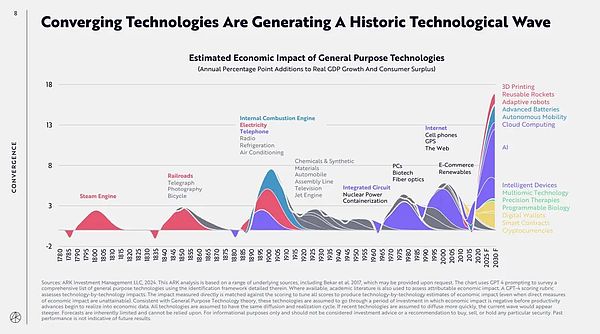
As one of the five major technologies, once large-scale adoption is achieved, all currencies and contracts will be moved to the public blockchain, supporting the verification of digital equity and proof of ownership.The financial ecosystem may be reconfigured to accommodate the rise of cryptocurrencies and smart contracts/decentralized finance (DeFi).
These technologies increase transparency, reduce the impact of capital and regulatory controls, and reduce contract execution costs.In such a world, as more and more assets are monetized/tokenized, businesses and consumers are gradually adapting to the new financial infrastructure.Then digital wallets that carry these assets will become increasingly important.The governance structure of the traditional corporate system will also be challenged.
2. Changes that public blockchain can bring
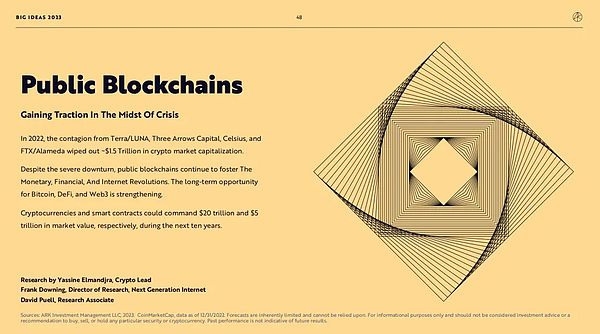
The proposal for public blockchain is mainly in the 2023 research report. ARK stated that despite the crypto industry experiencing a major earthquake in 2022, public blockchains continue to drive changes in currency, finance and the Internet.Long-term opportunities for Bitcoin, DeFi and Web3 are increasing.The market caps of cryptocurrencies and smart contracts may reach $20 trillion and $5 trillion respectively over the next decade.
2.1 The Money Revolution
Public blockchains can coordinate the transfer of value and ownership beyond the top-down control of governments and centralized institutions, thereby promoting the transition from centralized to globalization, decentralized, and non-sovereignty in the monetary system.
Existing problems: Centralized monetary system is difficult to provide strong guarantees for the global economy:
1) Four billion people live under an authoritarian regime;
2) More than 2 billion people suffer double-digit inflation;
3) More than 1 billion people cannot use traditional payment transfer applications;
4) More than one billion people rely on remittances.
The power of change mainly comes from cryptocurrencies represented by Bitcoin:
1) Bitcoin can ensure independent property rights, combine encryption technology and self-custody to ensure independent property rights;
2) Bitcoin is anti-inflation.Its quantity is mathematical and predictable.Currently, the supply of Bitcoin is 19 million, with a maximum of 21 million;
3) Bitcoin is censorship-resistant, the threshold for transactions is very low, and the only requirement is to own a private key;
4) Bitcoin is auditable and open and transparent.
2.2 The Financial Revolution
Public blockchains can reconstruct a set of decentralized financial technology facilities (DeFi) outside the traditional financial system to meet many needs that traditional financial systems cannot meet and solve many problems that traditional financial systems are difficult to solve.
Existing problems:
1) More than 2 billion people do not have access to basic banking services, including account management and credit;
2) The opacity of the financial system has caused many financial crises;
3) The risks that traditional financial institutions as counterparties can easily lead to single-point failure of the system, and centralized decision-making leads to rampant rent-seeking.
The power of change mainly comes from the newly built decentralized financial infrastructure (DeFi):
1) DeFi eliminates traditional intermediaries and automatically guarantees execution of smart contracts without the need for trusted subjects;
2) DeFi is global, with financial services deployed on open agreements allowing anyone with an internet connection to access custody, transaction and loan facilities;
3) DeFi is interoperable, and financial services are open source and interoperable, allowing for rapid innovation and experimentation;
4) DeFi is auditable and transparent, users manage risks themselves, and mortgages and capital flows are deposited in the ledger, and review is open.
2.3 The Internet Revolution
Public blockchains can help realize the identity, reputation and data of individual sovereignty beyond traditional groups and large technology companies, and realize the transition from corporate sovereignty to individual sovereignty ownership.
Existing problems:
1) The current development of Internet technology giants relies on the utilization, possession of user data and monetization;
2) Digital identities and reputations between various platforms cannot be interoperable;
3) Concentrated decision makers determine the discovery of information, subjectively adjusting content and communication.
The power of change comes mainly from the value economic system of Web3:
1) Web3 emphasizes personal sovereignty and introduces the concept of personal digital property rights;
2) Web3 depends on the protocol, not the platform.The decentralized protocol supports management and open access to distributed data, limiting the control of the central aggregator;
3) Web3 brings a new profit model, which embeds the economic system into the ecosystem, enabling users to monetize and participate in network development;
4) Web3 has achieved the integration of consumption and investment.As the economy becomes digital, consumer behaviors are also changing, giving birth to new business models of buying, owning and using.
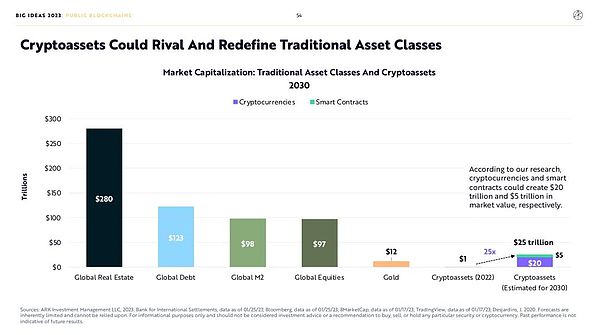
This public blockchain, which combines Bitcoin/cryptocurrency network, DeFi, Web3, will further redefine traditional assets and be able to achieve a total market value of $25 trillion (including 20 trillion crypto assets and5 trillion smart contract/DeFi protocol value).
3. Smart Contracts – Promote the Financial and Internet Revolution
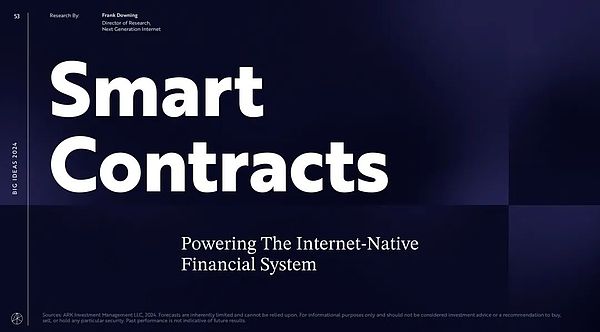
Smart contracts deployed on public blockchains after the catastrophic failure of centralized crypto institutions provide a global, automated and auditable alternative to decentralized financial infrastructure (DeFi) for the traditional financial systemplan.
Decentralization has proven to be more important in maintaining the original value proposition of public blockchain infrastructure.
According to ARK’s research, as tokenized financial assets gradually gained attention (such as stablecoins, tokenized US bonds, etc.), the size of their on-chain assets has achieved significant growth, and it is expected that the market value related to decentralized applications will beGrowing at a rate of 32% per year, from $775 billion in 2023 to $5.2 trillion in 2030.
The following are the main points:
3.1 Smart contracts are the basis of the value Internet financial system
It is still in its infancy, and smart contracts are providing power to the new financial system native to the Internet.Driven by Ethereum, the largest smart contract blockchain, multiple networks are supporting on-chain activity and competing for market share.
3.2 Stablecoins highlight the value proposition of smart contracts
Demand for stablecoins for USD digital channels is soaring given the hyperinflation in emerging markets and the intensification of global instability.Over the past three years, the number of active stablecoin addresses worldwide has grown at a rate of 93% per year, from 171,000 to 1.2 million.In 2023, stablecoins have exceeded MasterCard’s transaction volume.
3.3 The forward transfer of traditional financial assets to the chain
Tokenization enables asset management to be implemented on public blockchains, making it easier to verify tracking, trade and utilize funds than in traditional financial markets.In 2023, tokenized Treasury Funds grew by more than 7 times to $850 million.Early funds were launched on the Stellar blockchain, but Ethereum became the largest tokenized Treasury market in 2023.
3.4 Developers improve protocols during bear market
Faced with the 2022 crisis and its consequences, core developers have proposed a technology roadmap and reinforcement protocol to support the next bull market.Ethereum successfully achieved the Proof of Stake (PoS) consensus, and Solana also set a new record for continuous uptime.
3.5 Layer2 expands transactions in the Ethereum ecosystem
More than 20 Layer2 projects have been launched since the beginning of 2021, allowing Ethereum to expand its average daily transaction size by 4 times at a lower fee.Despite early success, most Layer2s are centrally controlled.The surge in Layer2 has brought complex experiences to users and developers.
3.6 Lower costs promote on-chain user stickiness
As transaction costs decline, on-chain participation (measured by the ratio of daily active address DAU to monthly active address MAU) increases.
3.7 Monolithic chains like Solana offer another option for vertical expansion
There are trade-offs in the design of smart contract network functions.By prioritizing underlying decentralization, the Ethereum ecosystem becomes more complex as it scales.By prioritizing the scalability of a single layer, Solana maintains a simple architecture for users and application developers and has achieved phased success.
3.8 Smart contracts can reduce financial services costs
The value of global financial assets surged from $140 trillion in 2000 to $510 trillion in 2020, the result of a combined effect of global economic growth, increased financialization and stock multiple expansion.The operating costs of the global financial system increase with the increase in the value of financial assets.The total annual revenue of the financial services industry is US$20 trillion, accounting for 3.3% of the value of all financial assets.Smart contracts can significantly reduce this drag on the global economy.
3.9 Smart contract networks will incur $450 billion in service fees by 2030
Smart contracts can promote the creation, ownership and management of on-chain assets at a cost far less than traditional finance.If tokenized assets migrate to blockchain infrastructure at a speed similar to the internet adoption, and the service rates associated with DeFi are one-third of traditional financial services, smart contracts can generate more than $450 billion in services each yearexpenses, creating more than $5 trillion in market value, grow at a CAGR of 78% and 32% by 2030, respectively.
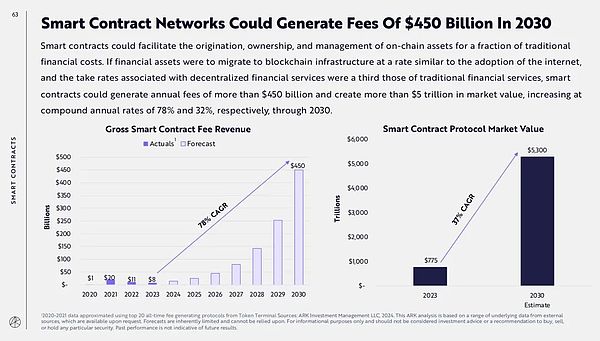
4. Digital wallet——eliminate traditional financial intermediaries
As ARK mentioned in its 2023 research report that public blockchain can transform existing systems at the three levels of currency, finance and the Internet. One of the solutions is smart contracts/DeFi, so who will carry these inTokenized assets on public blockchains must be mentioned.
Interestingly,Digital wallets in ARK research report are not equal to crypto wallets in public blockchainsAlthough some of the improved growth points in the digital wallet mentioned below can be achieved through Crypto/Blockchain Payment.
From the perspective of ARK, digital wallets use Blockchain to transform the traditional payment system (whether internal or external) to achieve cost reduction and efficiency improvement (closed-loop payment ecosystem), and combine with the huge consumers that digital wallets have accumulated before/ Merchant bonus, so that the value is reflected on the main company of the digital wallet.
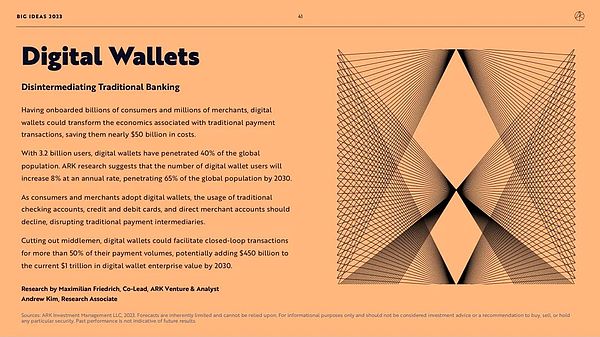
4.1 Overview of the current status of digital wallets
Digital wallets have attracted billions of consumers and millions of merchants, currently have 3.2 billion users, covering 40% of the world’s population.As consumers and merchants gradually adopt digital wallets, the usage of traditional checking accounts, credit cards, debit cards and direct merchant accounts will decline.
Digital wallets can fundamentally change the nature of traditional payment transactions—eliminating financial intermediaries.
Digital wallets can provide a closed loop for more than 50% of payment transactions, which will save the market nearly $50 billion in cost.By 2030, the value of digital wallet businesses could increase by an additional $450 billion from the current 1 trillion.ARK research shows that the number of digital wallet users will grow at an average annual rate of 8%, reaching 65% of the world’s population by 2030.
Vertical software applications are a set of solutions tailored to specific industry needs, such as Block, Shopify and Toast.Currently, leading vertical software applications are rapidly expanding to financial services on both consumers and merchants.Through a two-way network, this software can promote closed-loop transactions from consumers to merchants, merchants to employees, employees to merchants.
ARK believes that digital wallets on these applications will enable a completely closed payment ecosystem.According to ARK’s research, closed-loop consumer payments, commercial banks and employee wages/payments will grow at a rate of 22%-33% per year, from $7 billion in 2023 to 270 in 2030 -$50 billion.
The following are the main points:
4.2 Consolidate commercial and financial services and expand user consumption services
Block, Shopify and Toast are all attractive platforms that likely use digital wallets as the core of connecting consumers, merchants and employees’ ecosystems.In addition to supporting core business operations, they focus on digital wallets, work with partner banks and fintech companies, or activate their own banking licenses, thus eliminating the inefficient traditional financial institutions that interact with countless merchants.
At the same time, vertical software applications can not only realize a huge back-end business network, but also build a front-end consumer network through digital wallets.By simultaneously expanding commercial and consumer networks, vertical software applications are being closed-loop and become the operating system of these bilateral networks.
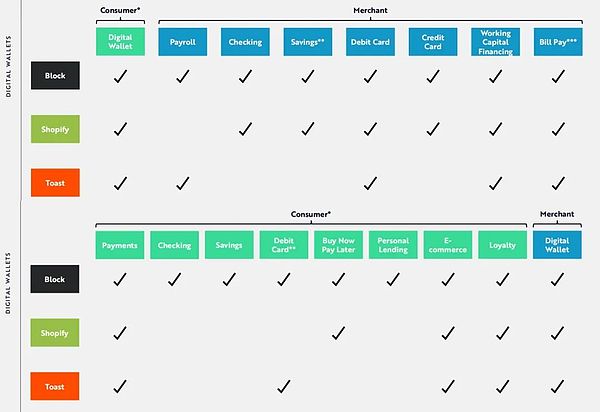
4.3closed loopPayEcosystem
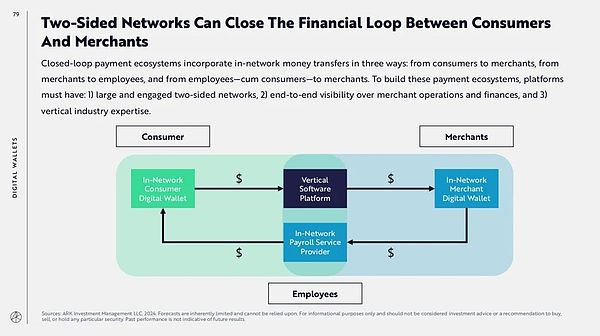
The closed-loop payment ecosystem combines the transfer of funds within the network in three ways: from consumers to merchants, from merchants to employees, and from employees and consumers to merchants.To build these payment ecosystems, the platform must have: 1) a large and active bilateral network; 2) end-to-end visibility into merchant operations and finance; and 3) vertical industry expertise.
Transactions using digital wallet balances bypass the bank and bank card networks, saving transaction fees for payment service providers, merchants and consumers.In ARK’s view, a vertical software platform with a large-scale consumer and merchant ecosystem can better utilize digital wallets to promote closed-loop transactions and achieve maximum profits.
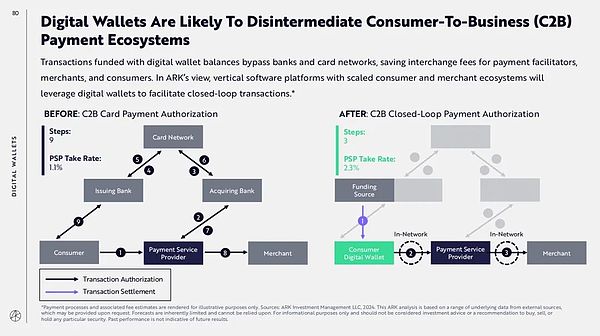
In 2022, Block paid approximately 60% of customer transaction fees to third parties for exchange, evaluation, processing and bank settlement fees.If Block’s front-end consumer-oriented app Cash App allows users to trade with Block merchants using their balances, Block’s net charges could more than double.
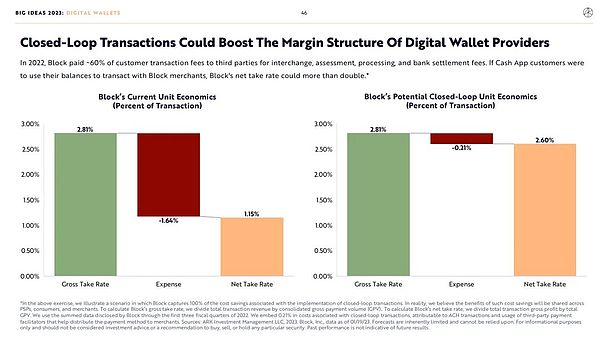
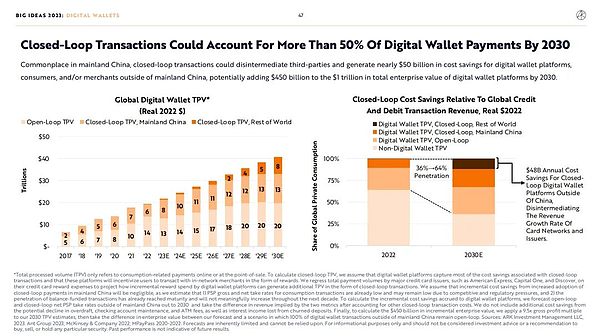
The closed-loop payment ecosystem is common in mainland China, which can eliminate the intermediary role of third parties and save nearly $50 billion in costs for digital wallet platforms, consumers and/or merchants outside of mainland China. By 2030, the total enterprise value of digital wallet platformsIt could increase by $450 billion.
In addition, in the 2024 report, ARK has specially added financial services for merchants and salary/payment of merchant employees to the closed-loop payment ecosystem.
According to ARK’s research, Block Square, Shopify and Toast’s core revenue will grow at 22% per year over the next seven years, from $7 billion in 2023 to $27 billion in 2030.By 2030, closed-loop payments businesses such as consumer payments, merchant financial services and employee wages/payments will generate $23 billion in additional revenue, increasing annual revenue growth from 22% to 33%.
5. Write at the end
Although the public blockchain industry will not have an “iPhone” moment like AI, its impact on transforming traditional architectures (especially traditional financial architectures) will be far-reaching, although this is a long-term path to change.
This path will start with financial payments, the most direct, or most capable of realizing value capture, is the payment company.
From the perspective of Wall Street Fund, digital wallet companies that currently have huge consumers/merchants on both ends have transformed the traditional payment system through stablecoins or internal settlement networks, after combining the capabilities of crypto/blockchain payment.The huge value growth it can bring to the company is reflected in the company’s share price.
This is the most direct way for Wall Street Fund to capture the value of Wall Street funds, and it is also the path that crypto can best use the off-chain world to realize Mass Adoption. This can be seen from the strategy of launching stablecoins in Solana after Paypal launched the stablecoin.


